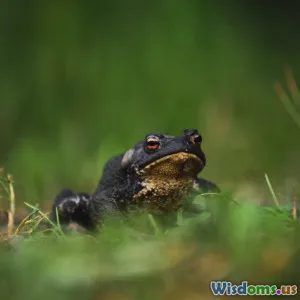
Innovative Technologies in Wildlife Conservation
8 min read Explore cutting-edge tech reshaping wildlife conservation and driving a sustainable future. (0 Reviews)
Innovative Technologies in Wildlife Conservation
Wildlife conservation is a critical pursuit in our rapidly changing world. As human activity increasingly threatens biodiversity, technology has become a powerful ally in protecting and understanding wildlife. From tracking elusive species to combatting poaching and habitat loss, innovative technologies are revolutionizing conservation methods. This article explores some of the most transformative technological advancements and how they are reshaping wildlife conservation efforts globally.
The Rising Need for Technology in Wildlife Conservation
The animal kingdom faces unprecedented challenges, including habitat destruction, climate change, illegal hunting, and pollution. According to the World Wildlife Fund's Living Planet Report 2022, global wildlife populations have declined by an average of 69% since 1970. Traditional conservation methods such as physical tracking and manual surveys are often limited by scale, accuracy, and resource constraints. This gap has been increasingly bridged by deploying cutting-edge technology to monitor, protect, and study wildlife with precision and efficiency.
As Dr. Phoebe Barnard, a prominent conservation biologist, states, “Technology isn't just a tool—it’s a lifeline that allows us to scale up our efforts to save endangered species before it's too late.”
Drone Technology: Eyes in the Sky
Unmatched Surveillance Capabilities
Drones have emerged as an indispensable asset in wildlife conservation. Equipped with high-resolution cameras and thermal imaging, drones can cover vast and inaccessible areas without disturbing wildlife. In Africa, conservationists use drones to track poachers in real time across sprawling savannahs.
For example, in Kenya's Maasai Mara reserve, drones help Rangers detect poachers early and reduce elephant poaching incidents by up to 60%. Additionally, drones have been essential for counting animal populations—such as penguins in Antarctica—where terrain and weather make foot surveys dangerous and impractical.
Use Case: Reforestation Efforts
Drone seed dispersal systems also aid in restoring habitats by planting native trees and vegetation over large areas quickly. This dual purpose of habitat protection and species preservation merges drone tech's versatility with conservation needs.
Artificial Intelligence and Machine Learning
Processing and Predicting Ecological Data
Artificial Intelligence (AI) has unlocked new possibilities in processing vast datasets gathered from camera traps, satellite images, and sensor networks. Machine learning algorithms can identify species from images and sounds automatically, saving thousands of man-hours and vastly improving accuracy.
For instance, Microsoft’s Project Premonition uses AI-powered sensors to track mosquitoes and predict outbreaks of vector-borne diseases that affect both animals and humans, indirectly aiding wildlife health.
Combatting Illegal Activities
AI also plays a crucial role in predicting poaching hotspots using predictive analytics based on historical poaching data, patrol routes, and environmental factors. This intelligence guides ranger deployment more effectively.
One notable example is the use of AI by the SMART (Spatial Monitoring and Reporting Tool) system, deployed in over 700 protected areas worldwide, improving anti-poaching efficiency dramatically.
Bioacoustics and Acoustic Monitoring
Listening to the Wild
Every species has a unique acoustic signature, from the songs of birds to the calls of whales. Bioacoustic technology involves deploying automated recording units throughout habitats to monitor wildlife presence, behavior, and population trends without human presence.
In the rainforests of the Amazon, researchers utilize acoustic sensors combined with AI to detect rare frogs, identify logging activity, and even track elusive jaguars. These datasets offer comprehensive insights into ecosystem health.
Real World Impact
The Wildlife Acoustics Echo Meter series enables citizen scientists and researchers alike to contribute to biodiversity monitoring by capturing bat echolocation calls and other wildlife sounds.
Genetic Technologies: DNA Barcoding and Environmental DNA (eDNA)
Decoding Biodiversity in Water and Soil
Sampling genetic material shed by organisms in their environment, known as environmental DNA (eDNA), allows scientists to detect species presence in waterways and soil without direct sightings.
This technology has been a game changer in discovering rare or invasive aquatic species. For example, eDNA was used to confirm the return of the critically endangered Yangtze giant softshell turtle, a species once feared extinct.
DNA Barcoding for Species Identification
DNA barcoding involves analyzing short genetic sequences unique to species, ensuring accurate identification that is vital for managing conservation priorities, combating illegal wildlife trade, and monitoring biodiversity.
Satellite Imaging and Remote Sensing
Tracking Habitat Changes and Animal Movements
The advent of affordable, high-resolution satellite imagery enables conservationists to analyze large-scale habitat changes over time. Remote sensing allows identification of deforestation, desertification, and the encroachment of urban areas affecting wildlife.
Satellite collars on animals provide detailed movement patterns, migration routes, and behavioral patterns necessary for crafting effective conservation strategies.
In 2021, researchers tracked Arctic polar bears via GPS collars for over a decade, gathering crucial data about how climate warming shifts their hunting grounds.
The Human–Tech Nexus: Challenges and Future Prospects
While these technologies provide powerful tools, challenges include high initial costs, technical expertise requirements, and concerns over data privacy and ethical implications, especially with drones and tracking devices.
To maximize impact, collaboration between technologists, ecologists, governments, and local communities is essential. Technology should empower, not replace, grassroots conservation efforts.
Looking ahead, emerging innovations such as blockchain for transparent wildlife trade monitoring, autonomous underwater vehicles to explore remote marine habitats, and advanced robotics promise even greater possibilities.
Conclusion: A New Era in Wildlife Conservation
Innovative technologies have fundamentally transformed wildlife conservation from reactive to proactive and data-driven. By integrating drones, AI, bioacoustics, genetic tools, and satellite monitoring, conservationists can protect species more effectively, combat illegal activities, and restore ecosystems.
As biodiversity loss accelerates worldwide, embracing technology is no longer optional but imperative. These scientific marvels serve as a testament to human ingenuity in harmony with nature—a beacon of hope that we can conserve the animal kingdom for generations to come.
“Technology alone won’t save wildlife, but without technology, many species stand no chance.” — Dr. Jane Goodall
It is crucial for policymakers, researchers, and citizens to champion these innovations and support continued advancements. Together, we can leverage technology and compassion to secure a diverse and thriving animal kingdom.
References:
- WWF Living Planet Report 2022
- SMART Conservation Analytics
- Microsoft Project Premonition
- Wildlife Acoustics
- National Geographic Polar Bear GPS Study 2021
Rate the Post
User Reviews
Popular Posts




















